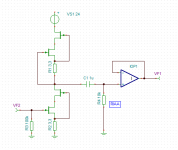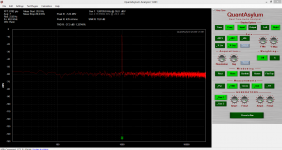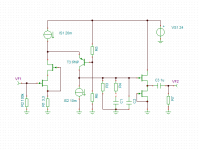So it is another contender for the:
astell kern schweiz
Colorfly | Colorfly Pocket HiFi | 192KHz/24Bit
iBasso
astell kern schweiz
Colorfly | Colorfly Pocket HiFi | 192KHz/24Bit
iBasso
Pono is really making noise  Sound bite: Despite Pono's promise, experts pan HD audio - CNET
Sound bite: Despite Pono's promise, experts pan HD audio - CNET
I did not publish much circuits recently. The main reason is the enormous response to the Paradise so i and the MPP team focussed on helping builders to make it work. What trigger me to try something new is the new book from Burkhard Vogel " How to Gain Gain ". It is about the use of Trodes in Audio Pre-Amps. Right in the preface of the first edition i read something striking:
"Because of their outstanding sound quality ( eventually mainly caused by an even harmonics distortion effect ) most of the involved valves in pre-amp stages are triodes or pentodes configured as trodes" sic! Read further and he talks even about purse or credit card! This from the undisputable Vogel.
A lot of water must have flown down the Rhine in recent years. So i though : is it really necessary to go to super low distortion to reproduce a vinyl record? The cartridge tracking produces something like 1% second at cruising levels. Some outstanding new designs even go as low as 0.1% (Lyra, new Ortofon et. al. ) but that's it. So going down much lower does not make much sense and accepting the new (old?) paradigm that even harmonic distortion can even sound "outstanding" i could setup a somewhat more relaxed technical profile for a new phono stage.
I also had the goal to use only one single ended class A gain stage plus a buffer. Even the Salas Simplistic has two stages and a buffer. The input J-Fet BJT cascode and a J-Fet drain follower. I also wanted to use transimpedance like in the Paradise but again single ended. The major problem with such a super high gain input stgae is thermal runaway. Over the years i have build much but i could only make it work with tubes.
Two years ago i presented a tube phono at ETF with a self biasing cascode and depletion mosfet cascode as CCS. With a Mu folower at the output i got a gain of 8000 x so this stage can be directly coupled to a power amp. Using selected 6C45Pi input tubes it was even good for MC. Not as super quiet as by best transistor efforts but the noise had a somewhat benign quality that did not detract much of the music. I am very pleased with that stage and use it often in my privat system.
Today then i made a breakthrough. I build a floating J-fet cascode with floating J-Fet cascode CSS that is thermally stable enough and gives around 60dB gain incl. RIAA so it can be used with MC. Noise impedance is around 20 Ohm. Better then an AD797 and not the best i can do but certainly better then my tube phono.
"Because of their outstanding sound quality ( eventually mainly caused by an even harmonics distortion effect ) most of the involved valves in pre-amp stages are triodes or pentodes configured as trodes" sic! Read further and he talks even about purse or credit card! This from the undisputable Vogel.
A lot of water must have flown down the Rhine in recent years. So i though : is it really necessary to go to super low distortion to reproduce a vinyl record? The cartridge tracking produces something like 1% second at cruising levels. Some outstanding new designs even go as low as 0.1% (Lyra, new Ortofon et. al. ) but that's it. So going down much lower does not make much sense and accepting the new (old?) paradigm that even harmonic distortion can even sound "outstanding" i could setup a somewhat more relaxed technical profile for a new phono stage.
I also had the goal to use only one single ended class A gain stage plus a buffer. Even the Salas Simplistic has two stages and a buffer. The input J-Fet BJT cascode and a J-Fet drain follower. I also wanted to use transimpedance like in the Paradise but again single ended. The major problem with such a super high gain input stgae is thermal runaway. Over the years i have build much but i could only make it work with tubes.
Two years ago i presented a tube phono at ETF with a self biasing cascode and depletion mosfet cascode as CCS. With a Mu folower at the output i got a gain of 8000 x so this stage can be directly coupled to a power amp. Using selected 6C45Pi input tubes it was even good for MC. Not as super quiet as by best transistor efforts but the noise had a somewhat benign quality that did not detract much of the music. I am very pleased with that stage and use it often in my privat system.
Today then i made a breakthrough. I build a floating J-fet cascode with floating J-Fet cascode CSS that is thermally stable enough and gives around 60dB gain incl. RIAA so it can be used with MC. Noise impedance is around 20 Ohm. Better then an AD797 and not the best i can do but certainly better then my tube phono.
Last edited:
Here you see a design that gives a lot of gain in the input stage :Pre phono 3 - MM-MC Analogic Phonografic Preamplification System "APPS" by B. Aloia
The inventor calls it " Totempole " because several stages are staked in series.
My design is similar to the Fet MM version in that it uses an input Fet that is cascoded.
Aloia uses a tube, i use another J-Fet. He then loads that stage with an SRPP.
That goes into a cathode folower that drives the passive RIAA.
I load my input stage with a Fet-Cascode CCS with fixed bias.
Only the input is modulated by the signal. I call that J - Fet Totempole, just to give it a name.
The inventor calls it " Totempole " because several stages are staked in series.
My design is similar to the Fet MM version in that it uses an input Fet that is cascoded.
Aloia uses a tube, i use another J-Fet. He then loads that stage with an SRPP.
That goes into a cathode folower that drives the passive RIAA.
I load my input stage with a Fet-Cascode CCS with fixed bias.
Only the input is modulated by the signal. I call that J - Fet Totempole, just to give it a name.
I have the complete RIAA working.
I set it up for 53dB gain.
That is enough for my system.
My Lyra Atlas puts out 1mV and i have a rather sensitive tube amp.
The circuit is a bit tricky concerning where to place the AC capacitors because the buffer also works with one PSU voltage only.
Distortion is dependent on the balance of the input stage. When it goes out of balance third harminic shows up. Other wise there is only second up to 1V output.
I put the input transistors in a copper container and i cool them.
Eather with a Peltier element ot a computer fan. Yes, that is a bit crazy but it works.
I set it up for 53dB gain.
That is enough for my system.
My Lyra Atlas puts out 1mV and i have a rather sensitive tube amp.
The circuit is a bit tricky concerning where to place the AC capacitors because the buffer also works with one PSU voltage only.
Distortion is dependent on the balance of the input stage. When it goes out of balance third harminic shows up. Other wise there is only second up to 1V output.
I put the input transistors in a copper container and i cool them.
Eather with a Peltier element ot a computer fan. Yes, that is a bit crazy but it works.
Absolute phase reversing, right? An SRPP input stage with a JFET+BJT cascode down the totem pole and Darlington top hat can have the RIAA EQ as an SRPP feedback active element and keep on the single stage and buffer phase reversing single rail theme also. Like in the Alex Nikitin's mid 90's Creeks. Few transistors fully discrete.
I know Alex circuit and i think it is good.
Yes, my circuit is phase inverting. Cartridge leads can be reversed.
I made some further measurements and i do not have enough gain in the bass with the 53dB version. 40dB is ok but i think more is a problem.
So i changed my strategy. I will go for a folded cascode that is loaded by a CCS.
I keep
the floating cascode at the input. I used that configuration several times and it worked well.
I could of cause cascode the input Fet with a BJT but the floating cascode is simpler-
Yes, my circuit is phase inverting. Cartridge leads can be reversed.
I made some further measurements and i do not have enough gain in the bass with the 53dB version. 40dB is ok but i think more is a problem.
So i changed my strategy. I will go for a folded cascode that is loaded by a CCS.
I keep
the floating cascode at the input. I used that configuration several times and it worked well.
I could of cause cascode the input Fet with a BJT but the floating cascode is simpler-



